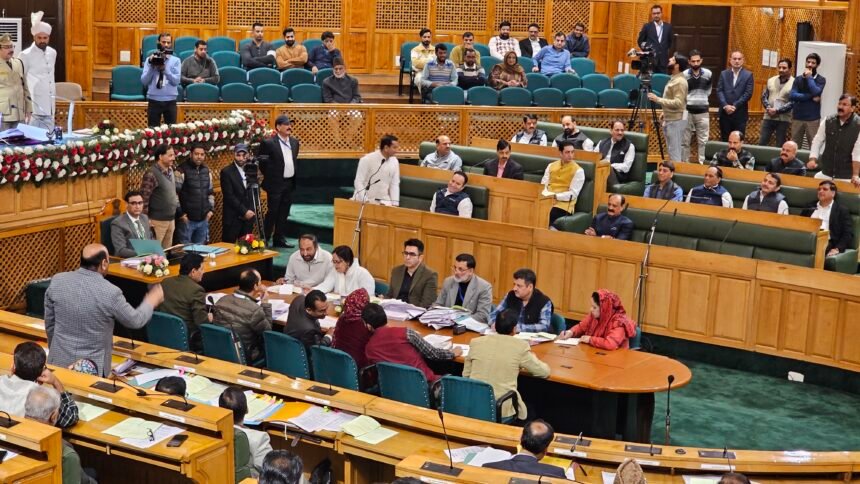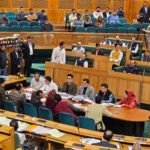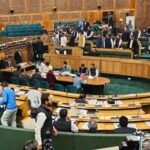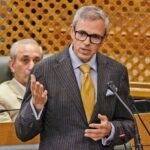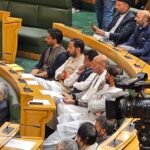NC MLA Tanvir Sadiq Urges Drug Awareness as Compulsory Subject in Schools
Calls for Dedicated Teachers in Every Class to Educate Students on Drug Dangers
Govt to Intensify Drug Awareness and Rehabilitation Efforts Across J&K
Health Minister Sakina Itoo
Minister Says Drug Awareness Now Part of School Curriculum; Morning Assemblies to Include Awareness Lectures
By Asif Iqbal Naik
Srinagar, October 28:
The Jammu & Kashmir Legislative Assembly on Tuesday witnessed an intense and emotional discussion over the rising menace of drug abuse, as legislators across party lines expressed alarm at the expanding reach of substance addiction among the youth.
The debate followed a question raised by Surjeet Singh (BJP) on measures to address the issue of “Drug Addiction” across the Union Territory.
In her response, Sakina Itoo, Minister for Health and Medical Education, said the government has adopted a multi-departmental strategy involving prevention, treatment, and rehabilitation. She stated that the departments of School Education, Higher Education, and Medical Education are working in coordination to strengthen initiatives on awareness and de-addiction.
“The government is working closely with the School Education, Higher Education, and Medical Education departments to strengthen awareness and rehabilitation initiatives. Drug awareness has already been introduced in the school curriculum, and we are considering daily awareness sessions during morning assemblies,” the Minister said.
She added that de-addiction and rehabilitation centres are functional across various districts, managed by trained professionals, and that outreach programmes are being carried out in schools, colleges, and panchayats.
During the discussion, NC MLA Tanvir Sadiq emphasised a structured educational approach:
“Drug awareness must be made a compulsory subject, and every class should have a dedicated teacher trained to counsel students about the dangers of drug addiction.”
Adding to the debate, BJP MLA Balwant Singh Mankotia said that while government action was crucial, the responsibility to fight the drug menace must also be shared collectively.
“Legislators cannot escape from their responsibilities. We cannot put all the blame on the government or the system. Each one of us — as public representatives and citizens — must contribute personally and collectively to stop and eradicate this threat from our society,” Mankotia asserted.
Similarly, Bani MLA Dr. Rameshwar Singh raised pointed questions about the functioning of the police department, alleging gaps in enforcement.
“If the youth in our areas know where drugs are being sold, why not the police?” he asked, claiming that narcotics are even being sold in and around the vicinities of some police stations in J&K. Dr. Singh called for exemplary punishment against those involved in the trade, including any officials found complicit, to restore public faith in the system.
Other members echoed concerns about the easy availability of narcotic substances in both urban and rural areas, calling for stronger coordination between enforcement agencies and health departments. They also demanded intensified village-level awareness campaigns involving religious leaders, social activists, and digital platforms to reach the youth.
Officials shared that under the outreach drive, the Health Department is conducting awareness camps, door-to-door surveys by health workers, and running de-addiction services in all 20 districts.
Concluding the session, the Speaker said the matter will be referred to the appropriate Assembly Committee for comprehensive policy recommendations.
Recent Statistics & Trends
To lend greater context to the discussion, here are the most recent publicly available figures:
• According to the Press Information Bureau (PIB), the number of cases registered in J&K under the NDPS Act were:
• 2020: 289 cases
• 2021: 357 cases
• 2022: 394 cases
• In 2022 alone, 1,124 NDPS cases were registered and 1,104 narcotic seizures made in J&K.
• Out-patient (OPD) de-addiction registrations across J&K:
• 2022: 9,775 persons
• 2023: 8,700 persons
• 2024: around 6,900–8,900 persons (depending on official source)
• Since 2018, over 1.12 lakh kg of narcotic substances have been seized across Jammu and Kashmir, indicating the scale of trafficking and consumption.
Social Impact and Youth Vulnerability
Experts and legislators alike have expressed concern that the drug crisis is no longer confined to specific localities but has penetrated towns, villages, and even educational campuses across Jammu and Kashmir. The youth population, particularly those aged between 17 and 30 years, has emerged as the most vulnerable group, often falling prey to peer pressure, unemployment, psychological distress, and easy availability of synthetic drugs.
Social workers and de-addiction professionals warn that rising substance use is tearing apart family structures, fuelling domestic violence, increasing petty crime, and deepening mental health disorders. Entire communities in several districts have reported a surge in school dropouts, theft incidents, and behavioural issues linked to addiction. The situation, if left unchecked, threatens to erode the social fabric and derail the developmental progress of the Union Territory.
Role of Religious Institutions and Community Leaders
Amid growing concerns, legislators also highlighted the vital role of religious institutions—including mosques, temples, gurdwaras, and churches—in raising awareness and promoting moral education against drug use. They stressed that Imams, priests, and temple heads can significantly influence social behaviour through sermons and community gatherings by conveying the ethical and spiritual dangers of addiction.
Religious leaders, several MLAs noted, are often the most trusted voices in their communities, capable of guiding families toward prevention and rehabilitation. Integrating anti-drug messages into Friday sermons, temple discourses, and social congregations can strengthen grassroots resistance to addiction. The Assembly urged that these faith-based bodies be officially engaged in government awareness campaigns as partners in the moral and social fight against narcotic abuse.
Implications for the Assembly Debate
The recent statistics and societal impacts reinforce the gravity of the Assembly’s discussion:
• The figures validate the MLAs’ concerns about the widespread reach of the drug menace.
• The strong statements by Mankotia and Dr. Rameshwar Singh reflect the need for shared responsibility and better law-enforcement accountability.
• Rising IPD (in-patient) admissions show that more severe addiction cases are surfacing, requiring advanced care.
• The social and familial damage being reported across districts justifies the demand for drug awareness as a compulsory school subject and a long-term, institutional response.
• The inclusion of religious and community institutions adds a moral and cultural dimension to the government’s strategy.
• The government’s commitment to expand awareness and rehabilitation must therefore be complemented by stronger enforcement, job creation, and youth engagement programmes to address root causes.

